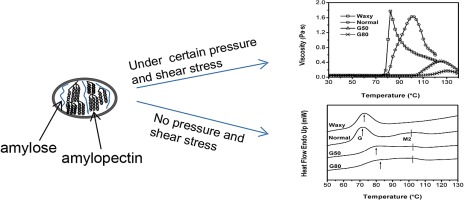当前位置:
X-MOL 学术
›
Food Hydrocoll.
›
论文详情
Our official English website, www.x-mol.net, welcomes your
feedback! (Note: you will need to create a separate account there.)
Effect of pressure with shear stress on gelatinization of starches with different amylose/amylopectin ratios
Food Hydrocolloids ( IF 11.0 ) Pub Date : Zhili Ji, Long Yu, Hongsheng Liu, Xianyang Bao, Yanfei Wang, Ling Chen
Food Hydrocolloids ( IF 11.0 ) Pub Date : Zhili Ji, Long Yu, Hongsheng Liu, Xianyang Bao, Yanfei Wang, Ling Chen

|
Effect of pressure with shear stress on the gelatinization of cornstarch with different amylose/amylopectin ratios (waxy 0/100; maze 23/77; G50 50/50; G80 80/20) was systematically investigated using a high-pressure rheometer. Onset and peak temperature of starch gelatinization as well as the peak viscosity were used to discuss the influence of pressure together with shear stress on the gelatinization of starch granules. The results showed that without shear stress, pressure could resist the gelatinization process due to weak swelling of starch granules and lower quantity of amylose released. However, the shear stress can simply counteract the influence of the pressure since its impact is much high on gelatinization. Under certain pressure and shear stress, both onset and peak temperatures of gelatinization were increased with increasing amylose content, which is in correspondence with the results from differential scanning calorimeter measurement, while the overall viscosity was lower when starches with a higher amylose content was used because part of its granular was not fully dissolved during the measurement. SAXS measurements were used to study the gel structure and stability of starch suspensions. It was found that the scattering intensity of starches in the measured range (0.1–1.0 nm−1) is G80 > waxy, indicating the amount of ordered semi-crystalline structures in amylose is higher. Peak values, q = 0.4 nm−1 and q = 0.2 nm−1, detected for waxy starch under different shear rates, indicates that higher shear stress which plays a dominant role compared with pressure, resulted in more degradation in amylopectin, inhibiting the formation of aggregate structure.
中文翻译:

压力和剪切应力对不同直链淀粉/支链淀粉比例的淀粉糊化的影响
使用高压流变仪系统地研究了剪切应力对不同直链淀粉/支链淀粉比率(蜡质0/100;迷宫23/77; G50 50/50; G80 80/20)对玉米淀粉糊化的影响。淀粉糊化的开始和峰值温度以及峰值粘度被用来讨论压力和剪切应力对淀粉颗粒糊化的影响。结果表明,在没有剪切应力的情况下,压力可以抵抗糊化过程,这是由于淀粉颗粒的溶胀性弱和释放的直链淀粉量较少。但是,剪应力可以简单地抵消压力的影响,因为其对糊化的影响很大。在一定的压力和剪切应力下,直链淀粉含量的增加,糊化的起始温度和峰值温度都增加,这与差示扫描量热法测量的结果一致,而当使用直链淀粉含量较高的淀粉时,由于其部分颗粒不完全,总体粘度较低在测量过程中溶解。SAXS测量用于研究淀粉悬浮液的凝胶结构和稳定性。结果发现,淀粉的散射强度在所测量的范围内(0.1–1.0 nm SAXS测量用于研究淀粉悬浮液的凝胶结构和稳定性。结果发现,淀粉的散射强度在所测量的范围内(0.1–1.0 nm SAXS测量用于研究淀粉悬浮液的凝胶结构和稳定性。结果发现,淀粉的散射强度在所测量的范围内(0.1–1.0 nm-1)是G80> 蜡状,表明直链淀粉中有序半结晶结构的数量较高。在不同剪切速率下检测到的蜡质淀粉的峰值q = 0.4 nm -1和q = 0.2 nm -1,表明较高的剪切应力(与压力相比起主要作用)导致支链淀粉的降解更多,从而抑制了形成总体结构。
更新日期:2017-06-21
中文翻译:

压力和剪切应力对不同直链淀粉/支链淀粉比例的淀粉糊化的影响
使用高压流变仪系统地研究了剪切应力对不同直链淀粉/支链淀粉比率(蜡质0/100;迷宫23/77; G50 50/50; G80 80/20)对玉米淀粉糊化的影响。淀粉糊化的开始和峰值温度以及峰值粘度被用来讨论压力和剪切应力对淀粉颗粒糊化的影响。结果表明,在没有剪切应力的情况下,压力可以抵抗糊化过程,这是由于淀粉颗粒的溶胀性弱和释放的直链淀粉量较少。但是,剪应力可以简单地抵消压力的影响,因为其对糊化的影响很大。在一定的压力和剪切应力下,直链淀粉含量的增加,糊化的起始温度和峰值温度都增加,这与差示扫描量热法测量的结果一致,而当使用直链淀粉含量较高的淀粉时,由于其部分颗粒不完全,总体粘度较低在测量过程中溶解。SAXS测量用于研究淀粉悬浮液的凝胶结构和稳定性。结果发现,淀粉的散射强度在所测量的范围内(0.1–1.0 nm SAXS测量用于研究淀粉悬浮液的凝胶结构和稳定性。结果发现,淀粉的散射强度在所测量的范围内(0.1–1.0 nm SAXS测量用于研究淀粉悬浮液的凝胶结构和稳定性。结果发现,淀粉的散射强度在所测量的范围内(0.1–1.0 nm-1)是G80> 蜡状,表明直链淀粉中有序半结晶结构的数量较高。在不同剪切速率下检测到的蜡质淀粉的峰值q = 0.4 nm -1和q = 0.2 nm -1,表明较高的剪切应力(与压力相比起主要作用)导致支链淀粉的降解更多,从而抑制了形成总体结构。













































 京公网安备 11010802027423号
京公网安备 11010802027423号